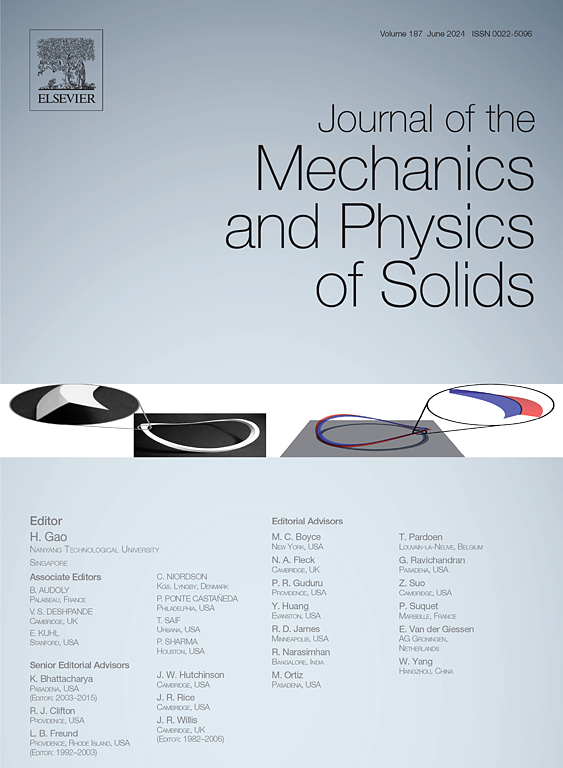Variational Linear Comparison estimates for the macroscopic response and field statistics of elasto-viscoplastic composites
IF 5
2区 工程技术
Q2 MATERIALS SCIENCE, MULTIDISCIPLINARY
引用次数: 0
Abstract
This work provides a generalization of the Variational Linear Comparison method (Ponte Castañeda, 1991) for elasto-viscoplastic (EVP) composites. To this end, use is made of Rayleigh’s least dissipation variational principle, leading to the characterization of the time-incremental macroscopic response of the composites in terms of suitably defined macroscopic Rayleigh potentials. By combining this variational framework with linearization schemes based on the notion of ‘comparison’ linear viscoelastic (LVE) composites, estimates are obtained for the macroscopic constitutive relation of the EVP composite in terms of the constitutive response of the comparison LVE composite, where the viscosities of the phases correspond to the secant viscosities of the phases of the EVP composite, evaluated at the instantaneous values of the second moments of the stress or strain-rate fields in the phases of the LVE comparison composite. The methodology is illustrated for particulate microstructures by application of the estimates of Willis (1977) for the comparison LVE composite, for which the use of time-differential operators can be exploited to generate evolution equations not only for the macroscopic fields but also for the field statistics — including the covariance of the fluctuations (which are not normally available from the correspondence principle). After testing the methodology for LVE composites, results are obtained for the class of EVP composites with particulate microstructures and general compressible, isotropic behavior for the phases. The new method recovers earlier results for the incompressible case, but it is also computationally robust when the phases are compressible (where other approximate methods have significant issues, especially when the phases are not well-ordered or when cyclic loading is applied), and it is the only method to date to be able to recover exactly, by construction, the limiting cases of purely elastic, purely viscoplastic and LVE behaviors.
弹粘塑性复合材料宏观响应和现场统计的变分线性比较估计
这项工作为弹粘塑性(EVP)复合材料提供了变分线性比较方法的推广(Ponte Castañeda, 1991)。为此,利用瑞利最小耗散变分原理,用适当定义的宏观瑞利势来表征复合材料的时间增量宏观响应。通过将该变分框架与基于“比较”线性粘弹性(LVE)复合材料概念的线性化方案相结合,根据比较LVE复合材料的本构响应,获得了EVP复合材料宏观本构关系的估计。其中,相的粘度对应于EVP复合材料相的割线粘度,在LVE比较复合材料相的应力或应变率场的第二矩的瞬时值下评估。通过应用Willis(1977)对比较LVE复合材料的估计,说明了颗粒微观结构的方法,其中可以利用时差算子不仅为宏观场而且为场统计生成演化方程-包括波动的协方差(通常不能从对应原理中获得)。在测试了LVE复合材料的方法后,得到了具有颗粒微观结构和相一般可压缩、各向同性行为的EVP复合材料的结果。新方法恢复了不可压缩情况下的早期结果,但当阶段是可压缩时,它在计算上也很稳健(其他近似方法有重大问题,特别是当阶段不是有序的或当循环加载时),并且它是迄今为止唯一能够通过构造精确恢复纯弹性,纯粘塑性和LVE行为的极限情况的方法。
本文章由计算机程序翻译,如有差异,请以英文原文为准。
求助全文
约1分钟内获得全文
求助全文
来源期刊
CiteScore
9.80
自引率
9.40%
发文量
276
审稿时长
52 days
期刊介绍:
The aim of Journal of The Mechanics and Physics of Solids is to publish research of the highest quality and of lasting significance on the mechanics of solids. The scope is broad, from fundamental concepts in mechanics to the analysis of novel phenomena and applications. Solids are interpreted broadly to include both hard and soft materials as well as natural and synthetic structures. The approach can be theoretical, experimental or computational.This research activity sits within engineering science and the allied areas of applied mathematics, materials science, bio-mechanics, applied physics, and geophysics.
The Journal was founded in 1952 by Rodney Hill, who was its Editor-in-Chief until 1968. The topics of interest to the Journal evolve with developments in the subject but its basic ethos remains the same: to publish research of the highest quality relating to the mechanics of solids. Thus, emphasis is placed on the development of fundamental concepts of mechanics and novel applications of these concepts based on theoretical, experimental or computational approaches, drawing upon the various branches of engineering science and the allied areas within applied mathematics, materials science, structural engineering, applied physics, and geophysics.
The main purpose of the Journal is to foster scientific understanding of the processes of deformation and mechanical failure of all solid materials, both technological and natural, and the connections between these processes and their underlying physical mechanisms. In this sense, the content of the Journal should reflect the current state of the discipline in analysis, experimental observation, and numerical simulation. In the interest of achieving this goal, authors are encouraged to consider the significance of their contributions for the field of mechanics and the implications of their results, in addition to describing the details of their work.

 求助内容:
求助内容: 应助结果提醒方式:
应助结果提醒方式:


